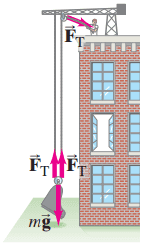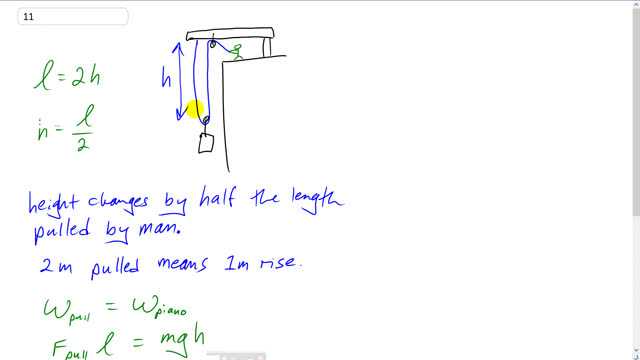
Recall from Chapter 4, Example 4–14, that you can use a pulley and ropes to decrease the force needed to raise a heavy load (see Fig. 6–37). But for every meter the load is raised, how much rope must be pulled up? Account for this, using energy concepts.


In order to watch this solution you need to have a subscription.
This is Giancoli Answers with Mr. Dychko. First, we are gonna compare the amount of length of rope that this man pulls in to the change in height of the piano. So the height is measured from the crane down to the piano and the length of the rope is, it starts from here and it goes all the way down to the piano and then back up and that length is gonna be 2 times the height because there is one leg down of the rope and then another leg up. So the length of rope is 2 times the height or you could say that the height is length divided by 2 which means that height changes by half the amount that the length changes so when the man pulls in 2 meters, that means the total length of rope here is reduced by 2 meters. And, well you can say, delta h equals delta l over 2 if you like. And so if the length changes by 2 meters then the height is gonna change by only 1 meter. And then, we'll use energy to talk about how the force compares between using a pulley or not? So when the man is, the work done by the man pulling on the rope is gonna equal the work done on the piano because, you know, conservation of energy says that has to be so assuming that there's no energy lost to friction and so on. So that means the force that the man pulls multiplied by the length of rope that he's pulling through is gonna equal the force on the piano, which is mg upwards; I mean, there's gravity down but if the piano is going at constant speed upwards, there must be a force up equal to gravity and then times by the change in height of the piano. And we just established that the change in height is the length of rope pulled divided by 2 so we'll make that substitution here and the l's cancel and that means that the force that the man is pulling with is mg over 2 so he pulls with half the force of the weight, which is the whole advantage of the pulley.
you said the length changes by 2 meters when the man pulls 2 meters, is the length not reduced by 1 meter according to the equation?
sorry I meant height instead of length**
Hi jagsandhu246, you're exactly right: when the rope is pulled 2 meters, the height of the load changes by only 1 meter, since . Just let me know if you have more questions about this since I'm not sure if I completely understood your question.
All the best,
Mr. Dychko
In the video you say that when the man pulls in a length of 2 meters the height is reduced by two meters. I think this is what they are referring to.
@1:30
Nevermind, I was mistaken- you hadn't finished your thought and it was at 30 seconds ish
Glad it ended up making sense. :)